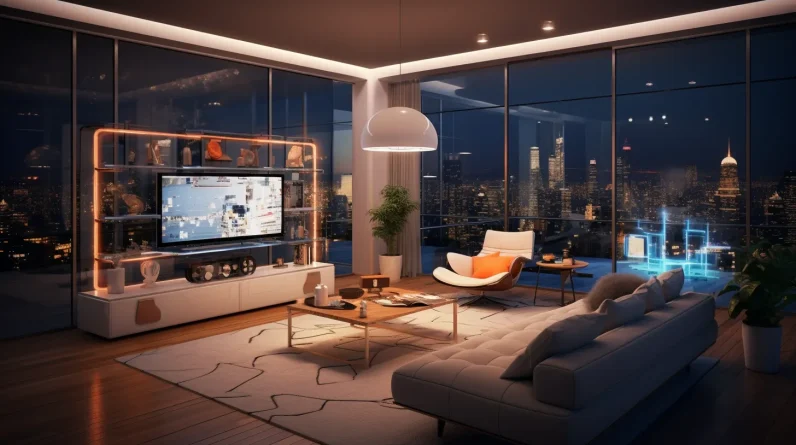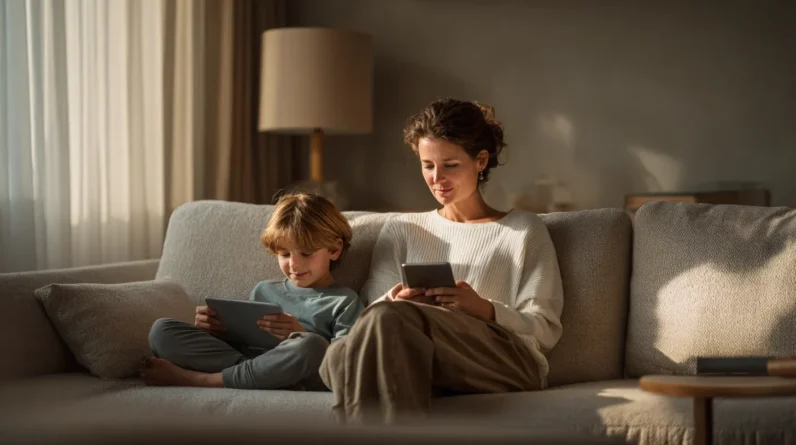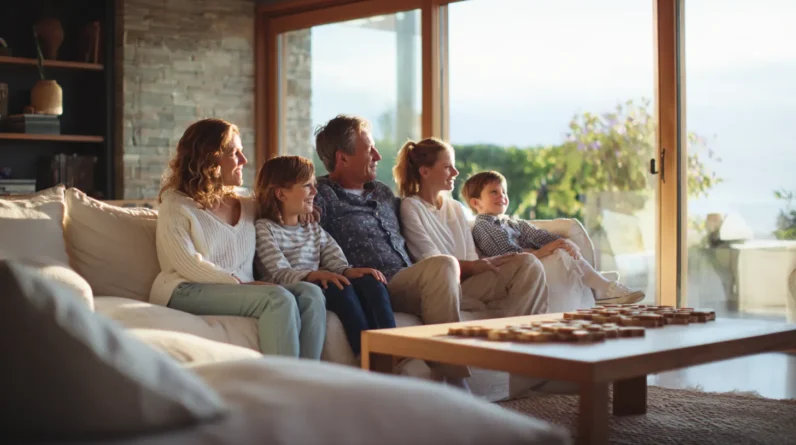
Smart Home Innovations for Aging in Place: Enhancing Independence and Comfort.
As we age, the desire for freedom and autonomy remains strong. With the rise of voice-activated assistants, smart locks, health monitoring systems, smart lighting, and home automation, older adults can now enjoy a more secure and convenient living environment.
These innovations not only simplify daily tasks but also promote safety, well-being, and peace of mind.
Join us as we explore the latest advancements in smart home technology designed to empower seniors to age in place with confidence.
Key Takeaways
– Voice-activated assistants enhance convenience and accessibility, revolutionizing home automation.
– Smart locks provide security and peace of mind by eliminating the need for traditional keys and allowing remote access control.
– Health monitoring systems empower seniors to manage their well-being by enabling remote monitoring of vital signs and sleep patterns.
– Smart lighting promotes safety and comfort in the home, improves visibility for seniors with visual impairments, and supports a healthy sleep-wake cycle.
Voice-Activated Assistants: Enhancing Convenience and Accessibility
Enhancing convenience and accessibility, voice-activated assistants offer a seamless and intuitive way for older adults to interact with their smart homes. These innovative devices have revolutionized the concept of home automation, providing older adults with greater control over their living environment.
One of the key benefits of voice-activated assistants is their ability to enhance home entertainment, thus promoting leisure and relaxation for older adults. With a simple voice command, they can effortlessly control their smart TVs, streaming services, and audio systems, creating a personalized entertainment experience. Whether they want to watch their favorite movies, listen to soothing music, or enjoy audiobooks, voice-activated assistants make it easier than ever before.
These assistants can act as virtual companions, reducing feelings of loneliness and isolation that older adults often experience. They can engage in natural conversations, provide companionship, and even offer reminders for medication or appointments. This virtual presence helps combat social isolation and provides a sense of companionship, giving older adults the freedom to stay connected with the outside world.
Smart Locks: Providing Security and Peace of Mind
With advanced technology and seamless integration, smart locks offer older adults a heightened sense of security and peace of mind for their homes. Home security is a top concern for many older adults who want to age in place independently. Smart locks provide a convenient and secure solution by allowing keyless entry and remote access control.
Smart locks eliminate the need for traditional keys, which can be easily misplaced or forgotten. Instead, they use advanced authentication methods such as fingerprint recognition, keypad codes, or even smartphone apps to grant access to the home. This eliminates the risk of unauthorized entry and provides a sense of freedom for older adults who may have difficulty managing physical keys.
In addition to keyless entry, smart locks also offer remote access control. This means that older adults can lock or unlock their doors from anywhere using their smartphones or other connected devices. This feature provides convenience and peace of mind, as they can ensure the security of their home even when they are not physically present.
Smart locks can be integrated into a larger smart home system, allowing for seamless automation and integration with other devices such as security cameras and doorbell cameras. This creates a comprehensive home security solution that can be easily managed and monitored.
Health Monitoring Systems: Empowering Seniors to Manage Their Well-Being
Interestingly, health monitoring systems provide older adults with the tools and resources necessary to actively manage their well-being. These innovative technologies enable seniors to monitor their health remotely, ensuring personalized care and peace of mind.
Remote monitoring systems, such as wearable devices and smart home sensors, allow older adults to track vital signs, activity levels, and sleep patterns from the comfort of their own homes. These devices can send real-time data to healthcare professionals, enabling early intervention and preventing potential health complications. For example, if a senior’s heart rate or blood pressure exceeds a predetermined threshold, an alert can be sent to their healthcare provider, who can then take appropriate action.
The use of health monitoring systems also promotes personalized care. By continuously monitoring vital signs and health metrics, these systems can provide tailored insights and recommendations based on an individual’s specific needs. For instance, if a senior has a chronic condition like diabetes, the system can track their blood sugar levels and provide reminders for medication or dietary adjustments.
Health monitoring systems empower older adults to take an active role in managing their well-being. By having access to real-time data and personalized insights, seniors can make informed decisions regarding their health. They can proactively engage in healthy behaviors, such as exercise and stress management, and take necessary precautions to prevent health issues.
Smart Lighting: Promoting Safety and Comfort in the Home
Smart lighting offers enhanced safety and comfort for seniors aging in place. By incorporating adaptive lighting systems into their homes, seniors can create a living environment that meets their specific needs and preferences.
Here are five benefits of smart lighting for seniors:
Improved visibility: Smart lighting systems can automatically adjust the brightness and color temperature of lights to provide optimal visibility for seniors with different visual impairments.
Promotes independence: With the ability to control lights through voice commands or smartphone apps, seniors can easily turn lights on and off without having to navigate through dark rooms, reducing the risk of falls.
Supports circadian rhythm: Smart lighting can be programmed to mimic natural daylight patterns, helping seniors maintain a healthy sleep-wake cycle and improving overall well-being.
Enhances security: Motion-sensor lights can be installed in key areas of the home, such as hallways and staircases, ensuring that seniors can navigate safely during the night.
Energy-efficient: Smart lighting systems use LED bulbs, which consume less energy compared to traditional incandescent bulbs, resulting in cost savings and a reduced environmental footprint.
Home Automation: Simplifying Daily Tasks for Aging Adults
As technology continues to advance, home automation systems are becoming increasingly popular among aging adults, simplifying their daily tasks and improving their quality of life. Home automation offers a range of features that promote home safety, independence, and autonomy for aging adults.
One of the key benefits of home automation is the ability to control various aspects of the home with ease. For example, smart thermostats can be programmed to adjust the temperature based on the occupants’ preferences, ensuring a comfortable living environment. Smart locks provide added security by allowing users to lock and unlock doors remotely, eliminating the need for physical keys. This feature is particularly useful for aging adults who may have difficulty manipulating traditional locks.
Home automation can greatly enhance home safety for aging adults. Motion sensors can detect movement and trigger lights to turn on automatically, reducing the risk of falls and accidents in poorly lit areas. Smart cameras provide real-time monitoring, allowing caregivers or family members to remotely check on their loved ones and ensure their well-being.
Home automation systems can empower aging adults to maintain their independence and autonomy. Voice-controlled devices enable hands-free operation of various household tasks, such as adjusting the lights, playing music, or even ordering groceries. Smart appliances, such as refrigerators with built-in inventory management systems, can help aging adults keep track of their food supplies and expiration dates, promoting healthier eating habits.
Frequently Asked Questions (FAQs)
What Are the Potential Privacy Concerns Associated With Using Voice-Activated Assistants in Smart Homes for Aging in Place?
Potential privacy concerns arise from the use of voice-activated assistants in smart homes for aging in place. These concerns relate to the collection, storage, and potential misuse of personal data, highlighting the need for robust security measures and transparent data handling practices.
Can Smart Locks Be Easily Hacked or Overridden, Compromising the Security of the Home?
Smart locks, like any other technology, may have vulnerabilities that could potentially compromise the security of a home. It is important for users to be aware of the potential risks and take necessary precautions to ensure the safety of their smart homes.
How Accurate Are Health Monitoring Systems in Detecting and Alerting to Potential Health Issues in Seniors?
Health monitoring systems for seniors have shown promising accuracy in detecting and alerting potential health issues. Wearable devices play a crucial role in monitoring vital signs, while fall detection systems effectively identify and notify caregivers in case of accidents.
Can Smart Lighting Systems Be Customized to Accommodate Specific Vision Needs for Seniors With Various Visual Impairments?
Smart lighting systems can indeed be customized to cater to the specific vision needs of seniors with various visual impairments. By incorporating lighting customization, these smart home innovations aim to enhance the independence and safety of aging individuals.
What Are the Potential Challenges or Limitations in Setting up and Using Home Automation Systems for Aging Adults?
Challenges and limitations exist when setting up and using home automation systems for aging adults. These may include technical difficulties, privacy concerns, and the need for customization to accommodate specific physical or cognitive impairments.
Conclusion
In conclusion, the advent of smart home innovations has revolutionized the way aging adults can comfortably and safely age in place.
Voice-activated assistants, smart locks, health monitoring systems, smart lighting, and home automation have all contributed to enhancing convenience, security, well-being, and daily tasks for seniors.
These technologies have truly transformed the concept of aging in place, empowering older adults to maintain their independence and live fulfilling lives in the comfort of their own homes.







